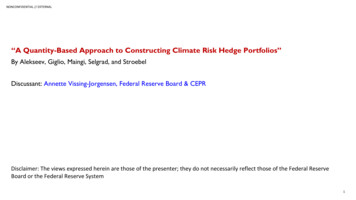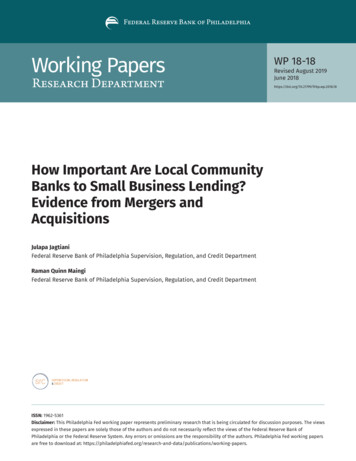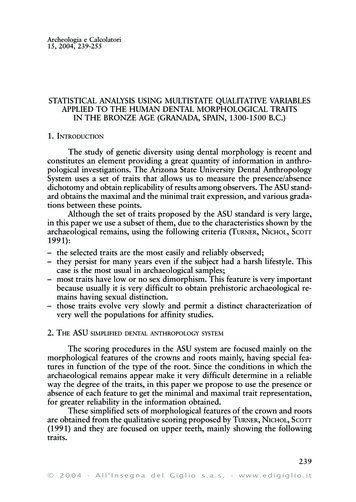
Transcription
NONCONFIDENTIAL // EXTERNAL“A Quantity-Based Approach to Constructing Climate Risk Hedge Portfolios”By Alekseev, Giglio, Maingi, Selgrad, and StroebelDiscussant: Annette Vissing-Jorgensen, Federal Reserve Board & CEPRDisclaimer: The views expressed herein are those of the presenter; they do not necessarily reflect those of the Federal ReserveBoard or the Federal Reserve System1
NONCONFIDENTIAL // EXTERNALSummaryObjective: Construct a long-short portfolio that has a high correlation with a chosen measure of climate newsPossibilities:A. Standard time-series approach to constructing “climate-mimicking” hedging portfolios:1. Using historical data: Determine which stocks (industries) go up in price in response to bad global heat news2. Going forward: These stocks should go up in price with bad global heat newsProblem: Limited historical data for step 1, though this is a problem that will get smaller over timeB. “Narrative” approach: Just conjecture which portfolios are likely to mimic climate newsC. Quantity approach of current paper:1. Determine which stocks (industries) are bought by locals (local equity mutual funds) in response to bad local heat news2. These stocks should go up in price with bad global heat news2
NONCONFIDENTIAL // EXTERNALComment 1. Defend the research question better. What would Greta Thunberg say about hedging?“Why should I be studying for a futurethat soon may be no more, when no one isdoing anything to save that future? And whatis the point of learning facts when the mostimportant facts clearly mean nothing to oursociety?”3
NONCONFIDENTIAL // EXTERNALComment 1. Defend the research question better. What would Greta say about hedging?YOU WANT TO GETRICH WHEN WE ALLDIE?STOP “HEDGING” ANDDO SOMETHING!4
NONCONFIDENTIAL // EXTERNALComment 1. Defend the research question better. What would Greta Thunberg say about hedging?Some possible answers:1. If some are more willing/able to bear a risk than others, then trading a hedging portfolio is welfare-improving Natural clienteles in climate context: Importance of believers vs, deniers well documented in housing climate financeo Effect of sea level rise on prices depends on fraction of people who believe climate change is happening(Baldauf, Garlappi, Yannelis, RFS 2020) Suggestion: In a simple calibration, how large is the welfare gain of hedging for various assumptions about disagreemento Under people’s own beliefso Given realistic modesty about how well hedging can be done in practice, or with perfect hedging Suggestion: What evidence is there on amount of actual hedging?o Lots of “E-tils”, but what fraction of “E-tilts” are hedging vs. “warm glow” vs. thinking it has high alpha? Survey?o Are the main climate hedgers in practice firms? Polluting firms who hedge the price of carbon permits using carbon futures? If so, we’re done: Hedge target carbon permit price, mimicking portfolio is based on carbon futures5
NONCONFIDENTIAL // EXTERNALComment 1. Defend the research question better. What would Greta Thunberg say about hedging?2. If hedging means tilting from brown to green stocks, then hedging helps the climate crisis (via costs of capital effects) Hedging portfolios here don’t look very green. Suggestions below Does require that investors are correct about what is greenBut, it’s also possible that hedging climate risk could have negative climate impact: If the most concerned can hedge climate risk, they may do less to mitigate it3. Financial stability: Hedging may prevent financial crises Is climate risk special? Credit risk, interest rate risk, cyber, war, pandemics, politics Hedging vs. higher capitalo Can you say something about the pros of hedging?o Or can correlation of bank stock returns with hedging portfolios be used to calibrate capital requirements?6
NONCONFIDENTIAL // EXTERNALSummary of quantity approachStep 1. Estimate climate-quantity-betas for each industry with respect to heat shock series S using county-level variationI industry, f fund, t time, loc(f) county of fund f You estimate one regression for each industry, using panel data across funds and timeStep 2. Quantity-based hedging portfolio, hedging US national heat shock series S (here f is riskfree, not fund) One time series of the hedging portfolio return for a given heat shock series SStep 3. Does it work? Calculate correlation of hedging portfolio return with various national measures of climate news Testing period is 2015-2019. Portfolios are constructed based on 5-years of monthly data (backward, rolling) The national measure could be the same as the one used locally (why is this not emphasized?), but many are considered7
NONCONFIDENTIAL // EXTERNALSummary of quantity approachStep 1. Local equity mutual funds buy auto, transportation, energy stocks when it’s hot locally (measured several ways)“the identities of industries that are bought/soldare not necessarily those expected ex ante”, but: Industries bought could, while currentlypotentially producers of emissions, bethe source of innovationHeads-up: Cohen, Gurun & Nguyenpaper on NBER LTAM April 9 As long as investors react consistentlyacross local and global shocks, itdoesn’t matter what they buy/sell There’s estimation noiseThe proof is in the pudding8
NONCONFIDENTIAL // EXTERNALSummary of quantity approachStep 3. Quantity based approach (blue labels) beats narrative approach (mostly) which beats standard approach (green labels).But avg. correlation w/climate news 0.2. Climate hedging is hard9
NONCONFIDENTIAL // EXTERNALComment 2. When does the quantity approach well? When not? Suggestions for improvementsQuantity-based approach used works well if: You have data on representative local investors Locals trade with non-locals in response to bad local heat news Investor demand reacts similarly to local and global heat news- Irrational reaction to local heat news that local investors think is global- Rational reaction to global heat news10
NONCONFIDENTIAL // EXTERNALComment 2. When does the quantity approach well? When not? Suggestions for improvementsQuantity-based approach used works poorly if: You have data for sophisticated local investors Locals trade with each other in response to bad local heat news- Unsophisticated locals (retail investors) sell brown, buy green stocks in response to bad local heat news- Sophisticated locals take the other side: They realize unsophisticated locals are trading based on irrelevant informationThen the hedge portfolio is long brown, short green and thus may do poorly, not well, in response to bad global heat news11
NONCONFIDENTIAL // EXTERNALComment 2. When does the quantity approach well? When not? Suggestions for improvementsWhich case are we in? Evidence from Choi, Gao and Jiang, RFS 2020 show importance of the problematic case Temperature variation across cities of the world with stock exchanges (local city for temp., country for holdings)- Stock trading of Emission-Clean (EMC) portfolio- Retail ownership 100% DataStream blockholders’ ownership FactSet institutional ownership excluding blockholders Retail investors (“the majority of which are local”) buy green & sell brown when local temperature is abnormally highLocal blockholders do the opposite when local temperature is abnormally high12
NONCONFIDENTIAL // EXTERNALComment 2. When does the quantity approach well? When not? Suggestions for improvementsSuggestion: Use the quantity approach for unsophisticated locals1. Really bad mutual fund managers (worst alpha? smallest funds?)2. Local retail investors at the county level (but hard to get data)3. Local retail investors at the country level (as Choi, Gao and Jiang, 2020).13
NONCONFIDENTIAL // EXTERNALComment 2. When does the quantity approach well? When not? Suggestions for improvementsSuggestion: Use a standard time-series return approach with local (country) information to get more data. Avg. across countries For each country and industry: Estimate climate return betas relative to local heat news For a given industry: Average climate return betas across countries Construct world-wide climate-hedge portfolio based on average climate return betas and world industry returns (or USindustry returns)This works if local investors’ trading affect prices in that country, which is true in Choi, Gao and Jiang (2020)14
NONCONFIDENTIAL // EXTERNALComment 3. What should we focus on in climate finance to have climate impact?How can investors have real climate impact?1. “Market-efficiency ESG investing” (profitable): Get climate information (regulatory/physical) “priced in” Ensures correct NPV calculations: If shareholders care, managers will need to care too Many climate finance papers are about this. Good But, “priced in” means prices reflect potential losses to current/future owners, not that carbon externalities are priced in2. “Money-losing ESG investing”: Investors with a preference for carbon reduction may be able to change relative costs of capital Closer to addressing externalities. Tilts to/from has parallels to taxes/subsidies Many climate finance papers assessing investors’ willingness to lose money. Good- Mixed empirical results. We may just get sorting of ownership with modest changes to equilibrium costs of capital- Few investors appear willing to lose much15
NONCONFIDENTIAL // EXTERNALComment 3. What should we focus on in climate finance to have climate impact?In surveys of ESG investors, many are interested in “market-efficiency” ESG investing BlackRock 2020 Global Sustainable Investing Survey16
NONCONFIDENTIAL // EXTERNALComment 3. What should we focus on in climate finance to have climate impact?17
NONCONFIDENTIAL // EXTERNALComment 3. What should we focus on in climate finance to have climate impact?So, realistically, to address externalities in a big way, government actions are important Is there a role for climate finance here? Yes There’s already a large climate finance literature on how to value public investments in mitigation/adaptation And we can do more: Help ensure “program efficiency”, in addition to market efficiencyo Document what works well, theoretically and empiricallyo Document cross-location inefficiencies: Equalize carbon reduction per dollar spent across locationso Monitor cross-location evasion: Relocation of production reduces effectivenessAm I the only one saying this? Not at all!18
NONCONFIDENTIAL // EXTERNALComment 3. What should we focus on in climate finance to have climate impact?Stroebel and Wurgler, 2021. Survey of 861 respondents about climate finance (academics, industry, government)19
NONCONFIDENTIAL // EXTERNALComment 3. What should we focus on in climate finance to have climate impact?20
o Lots of "E-tils", but what fraction of "E-tilts" are hedging vs. "warm glow" vs. thinking it has high alpha? Survey? o Are the main climate hedgers in practice firms? . Testing period is 2015-2019. Portfolios are constructed based on 5-years of monthly data (backward, rolling) .




